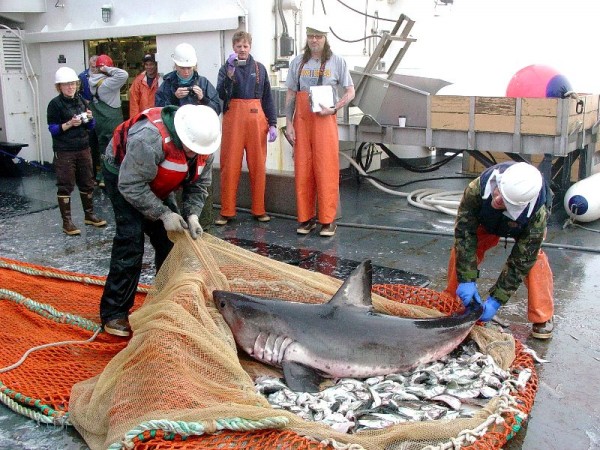The word ‘shark’ has become synonymous with the panic-inducing musical number that first appeared in Jaws in 1975.
Spielberg’s movie adaption of Peter Benchley’s novel by the same name, evoked an irrational fear towards sharks, and its aftermath is still being felt globally.
Whether you like them or not, sharks play a vital role in our marine ecosystem.
Their existence can be traced back 100-200 million years before dinosaurs walked the land. Today’s great white shark has barely had to evolve in the last 11 million years, and is virtually identical to its ancestors.
Sharks have survived in their own habitat for 400-450 million years, but human intervention has caused a rapid decline in their numbers.
Two more non-life threatening shark encounters on the mid New South Wales coast this month, have put sharks back on the agenda, but for all the wrong reasons.
English duo, Nicholas Curzon and Kathryn Hodgson, have dedicated their lives to changing the stigma associated with sharks.
They quit their jobs to embark on an eighteen-month journey to educate, inspire and empower people to save these animals.
In alliance with Shark Trust and Project AWARE, Curzon and Hodgson formed Friends For Sharks.
They moved to South Africa to work as dive guides, and have educated over 7,000 people in England, Canada, the Cook Islands, New Zealand and Australia.
Their talk at SeaLife Melbourne Aquarium was their eightieth event.
With 510 known species, Curzon and Hodgson say sharks are one of the most misunderstood creatures of the animal kingdom.
“We don’t want to raise another generation that is scared of sharks,” Hodgson tells upstart.
In fact, sharks have much more to fear from us than we do from them.
Humans kill at least 100 million sharks every year. That is 11,400 sharks per hour.
The main market is for their cartilaginous fins, that are considered a delicacy in many nations.
The fins are often hacked off while the animal is still alive; their bodies are disposed of at sea where they slowly bleed to death.
Hodgson describes this multi-million dollar industry as “a horrendous, wasteful trade”.
The pair also say that by removing sharks from our oceans, we’re meddling with coral reefs, other oceanic species, and our food sources.
“Most people eat fish, if you want fish stocks in the ocean, you need sharks. They are there to keep everything beautifully in balance,” Hodgson says.
“Sharks are the caretakers of the ocean.”
There are approximately only 3,000 great white sharks left in the world, that’s less than the number of tigers.
However, if you get caught catching and killing one in waters where they’re protected, you could face a $16,000 fine.
New Zealand has been the most welcoming nation of Friends For Sharks.
Great whites are highly respected in Maori culture; symbols representing sharks can be found in traditional carvings. They consider sharks a sign of luck and direction on nautical journeys.
Female great whites are larger than males, and have thicker skin. Both can live up to 70 years.
“Out of all the great whites born each year, only forty would survive to maturity, that’s before human influence,” Hodgson says.
Although it’s unknown how long a great white is fertile for, Curzon says they generally breed every two years, with males maturing between 12-25 years, and females between 15-33 years.
They go through about 50,000 teeth in their lifetime. The front row lasts about 30 days before it falls out and is replaced by the row behind.
They also have the same senses we do, only amplified, and like humans, have social structures and varying personalities.
Hodgson says it’s a common misconception that great whites have black eyes.
“People think sharks have soulless, dead eyes. It’s not true. When you see them in the sunlight, they have baby blue eyes and it gives them such a different look.”
Curzon says the fear that sharks are man-eaters is completely unfounded.
“Of course, we have to be careful when we’re in their environment, they need to have healthy respect given towards them,” he says.
“But they are not out to get us.”
A shark-spotting program in South Africa is proving to be a non-lethal alternative to keep both swimmers and sharks safe.
“The best tool for spreading awareness is getting in the water with them. But you have to do it properly,” Hodgson says.
Sharks regulate areas that cover two-thirds of our planet, and are responsible for more than half the oxygen we breathe. Healthy oceans need sharks; without them, marine life would be unbalanced and harmful to humans.
Shark attack survivor, Paul de Gelder, said a world without sharks is scarier than an ocean with sharks.
“It’d be really sad if we, in our lifetimes, have to go to a museum to see a shark as if they were dinosaurs,” he said.
At the end of their trip, all the money raised by Friends For Sharks will be divided equally between Shark Trust and Project AWARE.
“If you’ve got a voice then you can make a difference,” Hodgson says.
You can donate to Friends For Sharks here. It’s never been more important to donate, because by the time you’ve read this article, 850 sharks will have been slaughtered.
This is the third instalment of a multi-part series.
Stephanie Atkins is in her final year of a Bachelor of Journalism degree at La Trobe University. You can follow her on Twitter: @_steph_atkins_.








